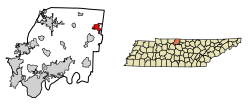Westmoreland, Tennessee facts for kids
Quick facts for kids
Westmoreland
|
|
|---|---|
| Westmoreland, Tennessee | |

Watertower in Westmoreland
|
|

Location of Westmoreland in Sumner County, Tennessee.
|
|
| Country | United States |
| State | Tennessee |
| County | Sumner |
| Incorporated | 1901 |
| Named for | Westmoreland (lumberman) |
| Area | |
| • Total | 4.36 sq mi (11.29 km2) |
| • Land | 4.34 sq mi (11.24 km2) |
| • Water | 0.02 sq mi (0.05 km2) |
| Elevation | 925 ft (282 m) |
| Population
(2020)
|
|
| • Total | 2,718 |
| • Density | 626.27/sq mi (241.78/km2) |
| Time zone | UTC-6 (Central (CST)) |
| • Summer (DST) | UTC-5 (CDT) |
| ZIP code |
37186
|
| Area code(s) | 615 |
| FIPS code | 47-79420 |
| GNIS feature ID | 1304492 |
| Website | westmorelandtn.gov |
Westmoreland is a small town in Sumner County, Tennessee, in the United States. It is located very close to the border of Kentucky. In 2020, about 2,718 people lived here. The town got its name from a rich lumberman from North Carolina who had the same name.
Contents
History of Westmoreland
Westmoreland has an interesting past. It was once an important railroad town. It is also home to one of the smallest railroad tunnels in the world!
The town officially became a part of Tennessee in February 1901. After that, it slowly grew to the size it is today.
In the early 2000s, Westmoreland Elementary School moved to a new building. The old school building is now called the Westmoreland Dream Center. It helps the community by collecting food for people in need and hosting Boy Scout activities.
The Little Tunnel
The town has a very tiny railroad tunnel. It is smaller than an average living room! This tunnel was built sometime between the early and mid-1900s. Today, it is known as the Little Tunnel. You can see a picture of this tunnel in a mural in the Town Square. The mural also shows other important buildings and places in Westmoreland.
Geography of Westmoreland
Westmoreland covers a total area of about 11.29 square kilometers (4.36 square miles). Most of this area is land, with a very small part being water.
Demographics
| Historical population | |||
|---|---|---|---|
| Census | Pop. | %± | |
| 1960 | 865 | — | |
| 1970 | 1,423 | 64.5% | |
| 1980 | 1,754 | 23.3% | |
| 1990 | 1,726 | −1.6% | |
| 2000 | 2,093 | 21.3% | |
| 2010 | 2,206 | 5.4% | |
| 2020 | 2,718 | 23.2% | |
| Sources: | |||
Who Lives in Westmoreland?
As of the 2020 United States census, there were 2,718 people living in Westmoreland. These people lived in 990 different homes. About 646 families called the town their home.
The table below shows the different groups of people who lived in Westmoreland in 2020:
| Group | Number of People | Percentage |
|---|---|---|
| White (not Hispanic) | 2,449 | 90.1% |
| Black or African American (not Hispanic) | 36 | 1.32% |
| Native American | 4 | 0.15% |
| Asian | 26 | 0.96% |
| Other/Mixed | 128 | 4.71% |
| Hispanic or Latino | 75 | 2.76% |
Gallery
See also
 In Spanish: Westmoreland (Tennessee) para niños
In Spanish: Westmoreland (Tennessee) para niños




